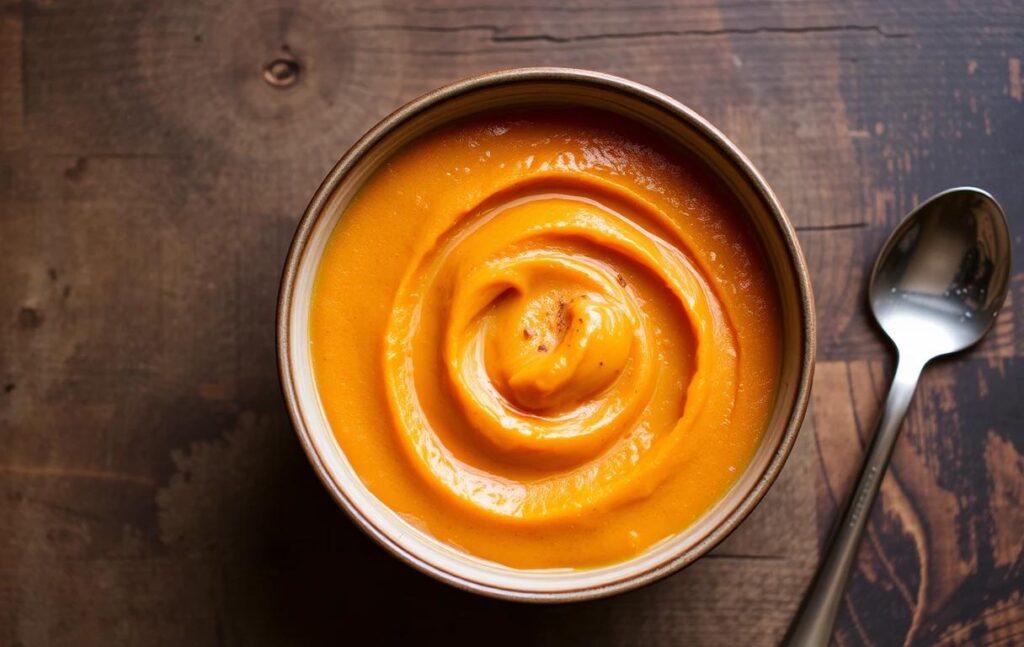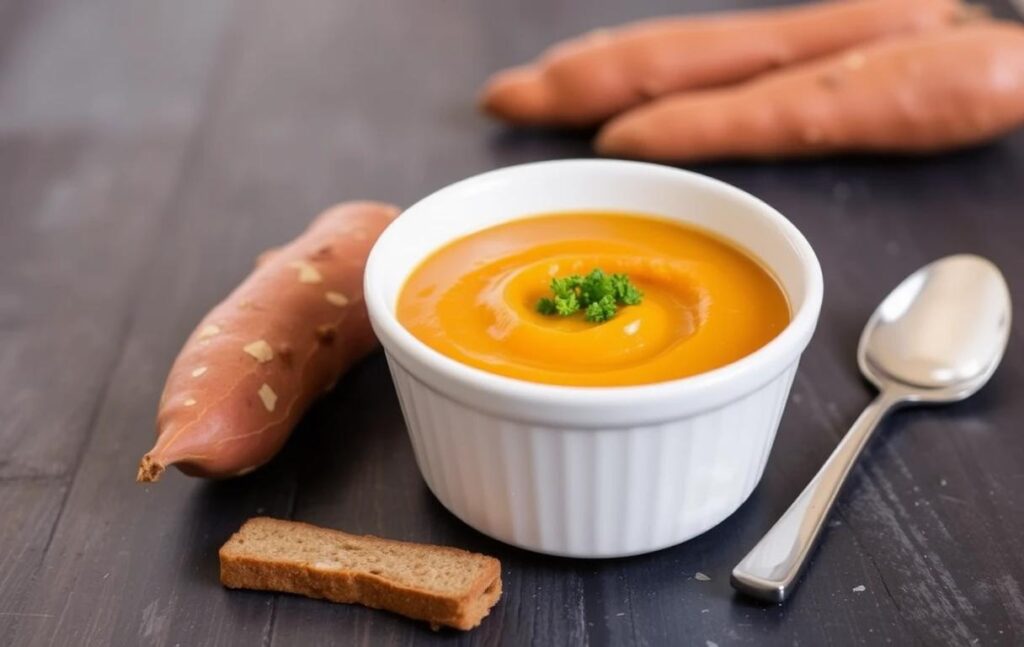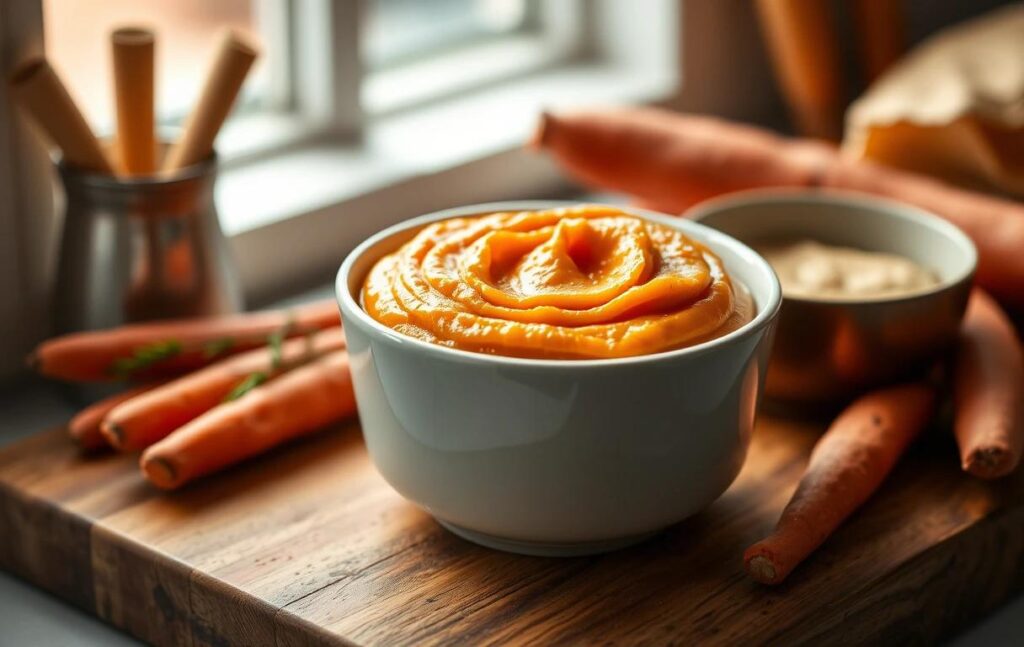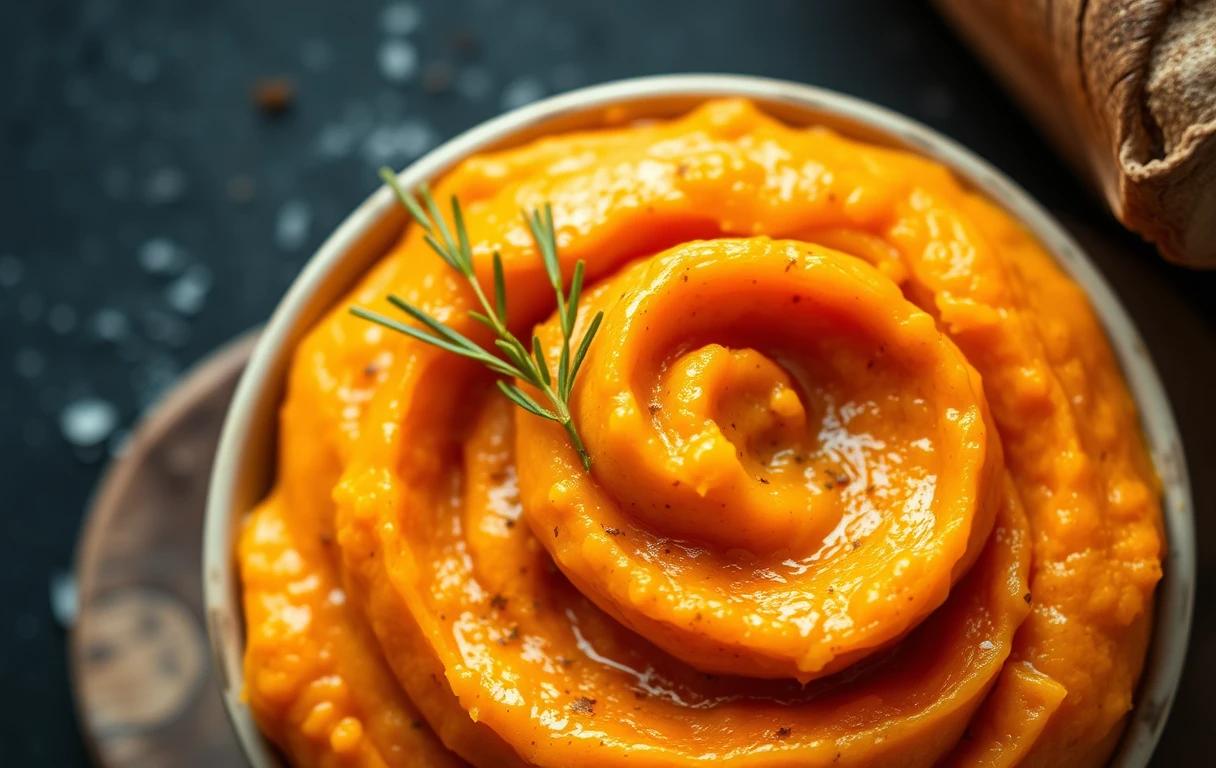Introduction to Sweet Potato Puree
Sweet potato puree is a versatile and delicious ingredient celebrated for its rich, natural sweetness and creamy texture. Made from cooked and blended sweet potatoes, this nutrient-packed puree is not only a culinary delight but also a powerhouse of essential vitamins and minerals, including vitamin A, fiber, and potassium.
This vibrant orange puree serves as the foundation for numerous dishes, ranging from savory soups and side dishes to decadent desserts and baked goods. Its smooth consistency makes it a popular choice for baby food, while its subtle sweetness and earthy flavor enhance recipes for people of all ages.
Whether you’re looking to add a wholesome touch to your meals or experimenting with creative recipes, sweet potato puree offers endless possibilities. Its ease of preparation and adaptability make it a staple ingredient in kitchens worldwide.
What is Sweet Potato Puree?
Sweet potato puree is a smooth, creamy mixture made by cooking sweet potatoes until tender and then mashing or blending them into a uniform consistency. Its vibrant orange color and naturally sweet, earthy flavor make it a popular ingredient in both sweet and savory dishes. Sweet potato puree can be homemade or purchased pre-prepared, offering convenience and versatility in the kitchen.
Importance in Culinary and Nutritional Contexts
Culinary Importance
Sweet potato puree is a beloved ingredient in culinary arts for its versatility and flavor. Its natural sweetness and smooth texture make it a base for various dishes, including:
- Soups, stews, and curries.
- Baking applications like muffins, pies, and cakes.
- Side dishes such as mashed sweet potatoes or spreads.
- Baby food, due to its gentle flavor and ease of digestion.
Additionally, it pairs well with spices like cinnamon, nutmeg, and cayenne, allowing for creative and dynamic recipes that cater to a range of tastes.
Nutritional Importance
From a nutritional perspective, sweet potato puree is highly valued for its dense nutrient profile. It is rich in:
- Vitamin A (as beta-carotene), essential for vision, immune health, and skin integrity.
- Dietary fiber, supporting digestion and gut health.
- Potassium, aiding in maintaining healthy blood pressure levels.
- Antioxidants, which help combat free radicals and reduce inflammation.
Low in fat and cholesterol, sweet potato puree is also a great option for those aiming to maintain a balanced diet or meet dietary restrictions. Its nutrient density makes it a go-to ingredient for boosting energy and promoting overall well-being.
In sum, sweet potato puree is not only a delightful culinary staple but also a superfood that supports a healthy lifestyle.
Sweet Potato Overview
History and Origin of Sweet Potatoes

Sweet potatoes (Ipomoea batatas) are one of the world’s most ancient crops, with origins tracing back thousands of years. Native to Central and South America, sweet potatoes were cultivated by indigenous peoples as far back as 8,000 to 10,000 years ago. Archaeological evidence suggests they were a dietary staple in regions such as Peru and the Yucatán Peninsula.
The spread of sweet potatoes beyond the Americas began in the late 15th century when explorers like Christopher Columbus encountered the crop and introduced it to Europe. By the 16th century, sweet potatoes had made their way to Africa, Asia, and the Pacific islands through trade routes. Today, they are a global crop, widely grown and consumed across tropical and temperate climates.
Varieties of Sweet Potatoes
Sweet potatoes come in a diverse array of varieties, distinguished by skin color, flesh color, flavor, and texture. The most common types include:
- Orange-Fleshed Sweet Potatoes
- The most widely recognized variety, known for its bright orange flesh and naturally sweet flavor.
- Rich in beta-carotene, a precursor to vitamin A.
- Popular in North America for dishes like casseroles and pies.
- White-Fleshed Sweet Potatoes
- These have pale flesh and a milder, less sweet flavor compared to their orange counterparts.
- They are drier and starchier, making them suitable for roasting or frying.
- Purple Sweet Potatoes
- Known for their vibrant purple flesh, attributed to anthocyanins, which are powerful antioxidants.
- Slightly earthy and nutty in flavor, commonly used in desserts and vibrant recipes.
- Popular varieties include Okinawan and Stokes purple sweet potatoes.
- Japanese Sweet Potatoes
- Distinguished by their reddish-purple skin and creamy white interior.
- They are sweet and nutty, often enjoyed simply roasted.
- Garnet and Jewel Sweet Potatoes
- Popular orange-fleshed varieties in the United States, known for their deep, rich sweetness.
- Often used interchangeably in recipes like mashed sweet potatoes or sweet potato fries.
- Beauregard Sweet Potatoes
- A widely cultivated variety in the U.S., with orange flesh and smooth skin.
- Known for its consistent sweetness and versatility in cooking.
Each variety offers unique flavors and textures, making sweet potatoes an adaptable ingredient for a wide range of culinary traditions worldwide. Their rich nutritional profile and global appeal ensure their place as a staple food crop and beloved ingredient.
Nutritional Benefits of Sweet Potatoes
Vitamins and Minerals in Sweet Potatoes
Sweet potatoes are a nutrient-dense food, offering an impressive array of vitamins, minerals, and other essential nutrients. Key nutrients include:
- Vitamin A (Beta-Carotene)
- Sweet potatoes are one of the richest sources of beta-carotene, a precursor to vitamin A.
- Vital for eye health, immune function, and skin integrity.
- Vitamin C
- Supports the immune system, promotes healthy skin, and aids in the absorption of iron.
- Vitamin B6
- Helps in brain development, mood regulation, and proper nervous system functioning.
- Potassium
- Regulates blood pressure, supports heart health, and aids muscle function.
- Manganese
- Important for bone health, metabolism, and antioxidant defense.
- Fiber
- Promotes digestive health, aids in weight management, and supports stable blood sugar levels.
- Antioxidants
- Found in high concentrations, especially in orange and purple varieties, to combat oxidative stress and reduce inflammation.
Health Benefits of Sweet Potato Puree
- Supports Vision Health
- The high vitamin A content promotes eye health and prevents night blindness.
- Boosts Immune System
- Rich in beta-carotene and vitamin C, sweet potato puree strengthens the immune system by supporting cell regeneration and combating infections.
- Aids Digestion
- The dietary fiber in sweet potatoes helps maintain a healthy digestive system by preventing constipation and promoting gut health.
- Helps Regulate Blood Sugar
- Despite its natural sweetness, the fiber content helps slow down sugar absorption, making it a good choice for managing blood sugar levels.
- Promotes Heart Health
- Potassium and antioxidants support cardiovascular health by reducing blood pressure and preventing oxidative damage to arteries.
- Anti-Inflammatory Properties
- The antioxidants in sweet potatoes, particularly anthocyanins in purple varieties, help reduce inflammation in the body.
- Weight Management
- The low-calorie and high-fiber nature of sweet potato puree can help create a sense of fullness, supporting weight control efforts.
- Energy Booster
- Sweet potatoes are a complex carbohydrate, providing sustained energy release, making the puree an excellent pre- or post-workout food.
- Supports Skin Health
- Vitamins A and C work together to maintain skin elasticity and combat signs of aging by promoting collagen production and protecting against free radicals.
- Baby and Senior Nutrition
- Easy to digest and packed with nutrients, sweet potato puree is ideal for babies, elderly individuals, or those with sensitive digestion.
Incorporating sweet potato puree into your diet not only adds a delightful flavor but also provides significant health benefits, making it a nutritious and versatile choice for all ages.
Uses of Sweet Potato Puree
Culinary Applications
Sweet potato puree is incredibly versatile and can be used in both savory and sweet dishes. Its creamy texture and natural sweetness make it a key ingredient in a wide variety of recipes.
- Savory Dishes
- Soups and Stews: Adds creaminess and depth of flavor to soups and hearty stews.
- Side Dishes: Acts as a base for mashed sweet potatoes, often enhanced with butter, herbs, or spices.
- Casseroles: Forms the foundation for sweet potato casseroles, often paired with toppings like marshmallows or nuts.
- Sauces: Used as a thickening agent in sauces or gravies.
- Breads and Flatbreads: Enhances the texture and flavor of savory breads and rolls.
- Sweet Dishes
- Desserts: Commonly used in pies, puddings, cakes, and cupcakes.
- Baked Goods: Adds moisture and sweetness to muffins, cookies, and bread.
- Breakfast Dishes: Mixed into pancake or waffle batter for a nutritious twist.
- Smoothies: Blended with milk, yogurt, or spices for a rich and creamy drink.
Baby Food
Sweet potato puree is one of the most popular first foods for babies due to its mild flavor, smooth texture, and nutrient density.
- Easy to Digest: Its softness and natural sweetness make it an ideal choice for infants just starting on solid foods.
- High in Nutrients: Provides essential vitamins (like A and C) and minerals (like potassium) crucial for a baby’s growth and development.
- Customizable: Can be mixed with other purees such as apples, carrots, or peas for variety and added nutrients.
Special Dietary Needs
Sweet potato puree is suitable for a wide range of dietary preferences and restrictions, making it a valuable ingredient for people with specific nutritional goals.
- Gluten-Free Diets
- Naturally gluten-free, it is often used as a thickener or base in gluten-free recipes, including bread and baked goods.
- Vegan and Vegetarian Diets
- Serves as a plant-based alternative in recipes, such as replacing eggs or dairy in baking.
- Low-Fat and Low-Calorie Diets
- A nutrient-rich option with low fat and moderate calorie content, making it ideal for weight management.
- Diabetic-Friendly Diets
- Though naturally sweet, the fiber in sweet potato puree helps regulate blood sugar, making it a suitable choice when consumed in moderation.
- Anti-Inflammatory Diets
- The antioxidants and anti-inflammatory properties of sweet potatoes make the puree beneficial for those with inflammation-related conditions.
- Elderly or Soft-Food Diets
- The smooth consistency is perfect for individuals with chewing difficulties or requiring easily digestible foods.
Sweet potato puree’s adaptability across culinary applications and its suitability for various dietary needs make it a staple ingredient for health-conscious and creative cooking.

How to Make Sweet Potato Puree
Ingredient Selection
- Choosing Sweet Potatoes:
- Select firm, unblemished sweet potatoes with smooth skin.
- Look for vibrant orange or purple varieties for a naturally sweet and creamy puree.
- Avoid any that are sprouting or have soft spots, as these may indicate spoilage.
- Quantity:
- Use about 2-3 medium-sized sweet potatoes for approximately 2 cups of puree.
- Adjust based on your recipe needs.
Cooking Methods
- Boiling
- Preparation: Peel and chop sweet potatoes into uniform chunks to ensure even cooking.
- Process: Place the pieces in a pot of boiling water and cook for 15-20 minutes or until fork-tender.
- Drain: Strain the water and let the sweet potatoes cool slightly before blending.
- Flavor Profile: Boiling retains a mild sweetness but may slightly dilute the flavor.
- Roasting
- Preparation: Preheat the oven to 400°F (200°C). Wash and dry the sweet potatoes.
- Process: Roast whole sweet potatoes on a baking sheet for 40-50 minutes or until soft.
- Peeling: Let them cool slightly, then remove the skin—it will peel off easily.
- Flavor Profile: Roasting caramelizes the natural sugars, intensifying the sweetness and giving a richer flavor.
- Steaming
- Preparation: Peel and chop sweet potatoes into chunks.
- Process: Place the pieces in a steamer basket over boiling water and cover. Steam for 20-25 minutes or until soft.
- Flavor Profile: Steaming preserves the nutrients and maintains a fresh, sweet taste.
Blending Tips
- Equipment:
- Use a blender, food processor, or hand masher for pureeing. A high-powered blender will yield the smoothest texture.
- Blending Process:
- Boiled or Steamed Potatoes: Add a small amount of water, milk, or broth (if desired) to help achieve a creamy consistency.
- Roasted Potatoes: Usually moist enough to blend without additional liquid.
- Consistency Adjustments:
- For thicker puree: Blend with minimal liquid.
- For thinner puree: Gradually add liquid until the desired consistency is reached.
- Enhancing Flavor:
- Add a pinch of salt, cinnamon, nutmeg, or a drizzle of maple syrup for sweet applications.
- For savory recipes, mix in a touch of garlic, butter, or herbs.
- Cooling and Storage:
- Let the puree cool completely before storing.
- Store in an airtight container in the refrigerator for up to 5 days or freeze for longer storage.
By selecting the best sweet potatoes, using the right cooking method, and blending with care, you can create a smooth, flavorful puree perfect for a variety of dishes.
Storage and Shelf Life
Refrigeration Tips
- Store sweet potato puree in an airtight container to prevent it from absorbing odors or losing moisture.
- Refrigerate at or below 40°F (4°C) and use within 4–5 days for optimal freshness.
Freezing Techniques
- Portion the puree into airtight containers or silicone ice cube trays for easy thawing.
- Label with the date and freeze for up to 3 months. Thaw in the refrigerator overnight before use.
How to Tell If It’s Gone Bad
- Check for sour or off smells, mold growth, or a slimy texture. Discard if any of these signs are present.
Creative Recipes

Sweet Recipes
- Sweet Potato Pie: A classic dessert with creamy puree, warm spices, and a flaky crust.
- Muffins: Sweet potato adds moisture and natural sweetness to baked goods.
- Cakes: Use puree for rich, moist layers in a spice cake or bundt cake.
Savory Recipes
- Sweet Potato Soup: Blend with broth, garlic, and a touch of cream for a velvety soup.
- Casseroles: Combine with cheese, herbs, or breadcrumbs for a hearty dish.
- Sauces: Mix with coconut milk or broth for a smooth sauce to accompany proteins or pasta.
Sweet Potato Puree for Babies
Benefits for Babies
- Packed with nutrients like vitamin A, potassium, and fiber for growth and development.
- Gentle on digestion and naturally sweet, making it appealing for infants.
How to Introduce It to Infants
- Start with a smooth puree and gradually introduce thicker textures as the baby grows.
- Mix with breast milk, formula, or water for a milder taste.
Comparison with Other Purees
Sweet Potato Puree vs. Pumpkin Puree
- Flavor: Sweet potato puree is naturally sweeter, while pumpkin is milder.
- Texture: Sweet potato puree is thicker and creamier.
- Nutrition: Both are nutrient-dense, but sweet potatoes have higher vitamin A content.
Sweet Potato Puree vs. Carrot Puree
- Flavor: Sweet potato is sweeter, while carrot puree has a slightly earthy taste.
- Usage: Sweet potato is more versatile in desserts, while carrot is common in soups and savory dishes.
Cultural Significance
Sweet Potato Dishes Around the World
- United States: Sweet potato casseroles and pies are holiday staples.
- Japan: Roasted sweet potatoes (yaki imo) are a favorite snack.
- Caribbean: Sweet potato puddings and stews are traditional dishes.
Festive Uses of Sweet Potato Puree
- Central to Thanksgiving and Christmas meals, often featured in pies, casseroles, or soufflés.
Tips for Enhancing Flavor
Spices and Herbs to Pair with Sweet Potato Puree
- Sweet: Cinnamon, nutmeg, allspice, ginger, and vanilla.
- Savory: Rosemary, thyme, garlic, and smoked paprika.
Sweet and Savory Enhancements
- Sweet: Add maple syrup, honey, or brown sugar.
- Savory: Incorporate butter, cheese, or coconut milk for richness.
Dietary Suitability
Sweet Potato Puree for Vegans
- Naturally vegan and ideal for plant-based recipes.
- Can replace dairy or eggs in baking to add moisture and richness.
Gluten-Free, Keto, and Other Diets
- Gluten-Free: Perfect as a base or thickener in recipes.
- Keto: Limited in keto diets due to carbohydrate content but may be used in small amounts.
- Paleo: Fully compatible with paleo eating guidelines.
Common Mistakes to Avoid
- Overcooking or Undercooking
- Overcooking leads to watery puree; undercooking results in lumps.
- Cook until just fork-tender for the best consistency.
- Incorrect Storage Methods
- Avoid leaving puree at room temperature for extended periods. Always refrigerate or freeze promptly.
Frequently Asked Questions (FAQs)
- Can I use canned sweet potatoes for puree?
- Yes, but check for added sugar or preservatives that may alter the flavor.
- How do I reheat frozen puree?
- Thaw overnight and reheat gently in a microwave or stovetop, stirring frequently.
- Can I add sweet potato puree directly to baking recipes?
- Yes, it works well in cakes, muffins, and bread to add moisture and sweetness.
Conclusion
Sweet potato puree is a versatile, nutrient-packed ingredient that enhances both sweet and savory dishes. From its significant health benefits to its wide range of uses in global cuisine, this ingredient is a must-have for creative cooking and balanced diets. Whether you’re a seasoned chef or exploring new flavors, sweet potato puree offers endless possibilities. Try incorporating it into your next meal to enjoy its delicious taste and numerous health benefits!
For More Recipes
a pretty life in the suburbs marshmallow vanilla buttercream
mississippi mud pie ice cream
boston cream pie near me
vegan barley soup

